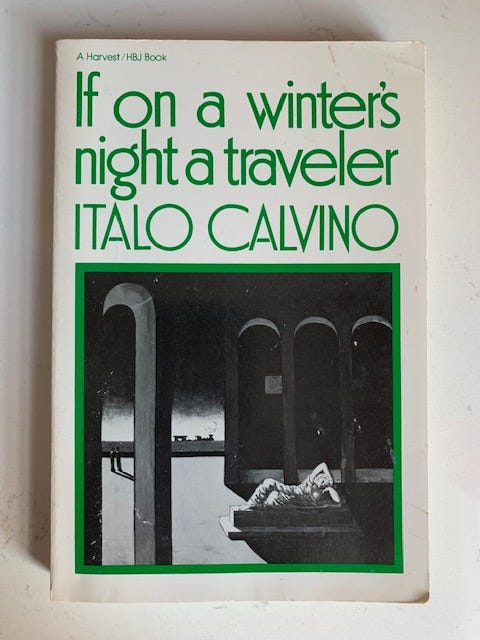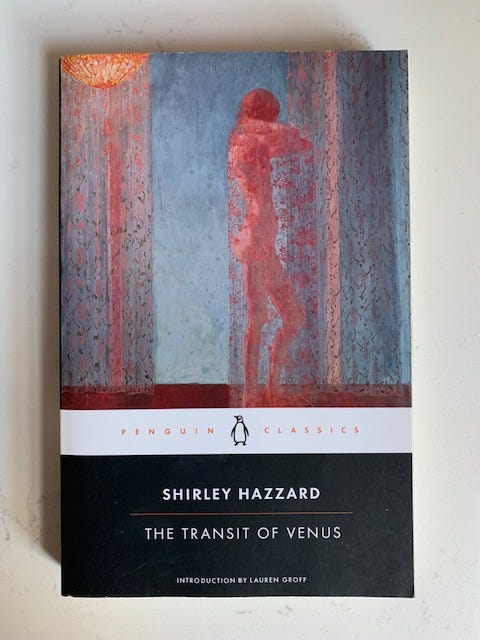'If on a winter's night a traveler' by Italo Calvino
'I didn't mean to discuss; I wanted to read...'—Review #165

‘I need to mail you a book,’ was the text message I received out of the blue back in February from Nazim, one of my dearest friends. A few days later, Italo Calvino’s ‘If on a winter’s night a traveler’ arrived. When I thanked Nazim for sending the book, he told me I didn’t need to review it; it could be solely for my enjoyment. I chuckled. I hardly know what reading purely for pleasure is anymore, since everything I read is funneled into this newsletter. Even so, I briefly considered putting the book aside to read during a break from Books on GIF. But positive reaction to my social media posts about this book suggested that I should do a newsletter so we could all discuss it.
Here’s the cover:
If you enjoy this review, click the ♥️ above or
New here? Learn more
I had read and enjoyed Calvino’s ‘Invisible Cities’ prior to Books on GIF’s existence, and always meant to revisit his work, but I went into ‘If on a winter’s night a traveler’ completely blind. Right away, I realized:

You, the reader, are the male protagonist. You’re trying to read Calvino’s novel, except you can’t. It cuts off abruptly. You try to find the remaining pages, guided by the book itself (yes, the book acts as the narrator), and you enlist a fellow reader, a woman, to help, but instead, you find an excerpt of another novel with a completely different setting and cast of characters. It suddenly cuts off, too. You continue your journey to finish that novel, but are detoured through several others. One feels like Russian literature. Another, Japanese. A third, a spy novel. The details of these novels, though interesting, are not important in themselves, but they converge into a meta-story about:

‘If on a winter’s night a traveler’ is a book about books: the agony of writing them; the indifferent efforts to market, produce and distribute them; and, most importantly, the joys of collecting, reading and trying to understand them. In one scene, the woman who helps you (her name is Ludmilla) sends you to a publishing house to inquire about one of the cut-off novels. She can’t go with you, she says, because seeing how a book is made would ruin her reading experience. In another scene, you visit an academic to see if he has more of one of the novels. There, you meet Ludmilla’s sister, Lotaria, who is overbearing about books and their meaning. In yet another, an author, Silas, writes in his diary about using a spyglass to observe a woman reading. He muses about the words he types in his typewriter somehow appearing instantaneously to her in her book. I wonder what Calvino would have made of:
All of this may seem complicated, and believe me, it is, but Calvino makes it work. I’m in awe of his ambition, technical proficiency and style. ‘If on a winter’s night a traveler’ is one of the most fascinating and frustrating books I’ve ever read. It has a lot to say, way more than I could do justice to here. Its nontraditional narrative is sometimes challenging to follow. Also, it’s beautiful. Calvino reminds us that there are many ways to approach a book, whether for pleasure or for critique or to appear smart, but we must always keep in the back of our mind a space to appreciate beauty and joy in literature. Because:

And this is what I think Nazim was trying to tell me. He was warning me against turning reading solely into labor. Thank you for that, my friend. I’m glad you sent me this book. It was a pleasure to read. As I flipped through its pages, I saw margin notes scrawled in tiny handwriting by a previous owner. Phrases caught my eye: ‘drop all presumptions,’ one note read. ‘Imbibe the book,’ said another. Perfect guidance from another reader. You should all imbibe this book.
How it begins:
You are about to begin reading Italo Calvino’s new novel, If on a winter’s night a traveler. Relax. Concentrate. Dispel every other thought. Let the world around you fade. Best to close the door; the TV is always on in the next room. Tell the others right way, “No, I don’t want to watch TV!” Raise you voice—they won’t hear you otherwise—“I’m reading! I don’t want to be disturbed!” Maybe they haven’t heard you, with all that racket; speak louder, yell: “I’m beginning to read Italo Calvino’s new novel!” Or if you prefer, don’t say anything: just hope they’ll leave you alone.
Find the most comfortable position: seated, stretched out, curled up, or lying flat. Flat on your back, on your side, on your stomach. In an easy chair, on the sofa, in the rocker, the deck chair, on the hassock. In the hammock, if you have a hammock. On top of your bed, of course, or in the bed. You can even stand on your hands, head down, in the yoga position. With the book upside down, naturally.
Of course, the ideal position for reading is something you can never find. In the old days they used to read standing up, at a lectern. People were accustomed to standing on their feet, without moving. They rested like that when they were tired of horseback riding. Nobody ever thought of reading on horseback; and yet now, the idea of sitting in the saddle, the book propped against the horse’s mane, or maybe tied to the horse’s ear with a special harness, seems attractive to you. With your feet in the stirrups, you should feel quite comfortable for reading; having your feet up is the first condition for enjoying a read.
My rating:
‘If on a winter’s night a traveler’ (‘Se una notte d’inverno un viaggiatore’) by Italo Calvino was published in the original Italian in 1979 by Giulio Einaudi editore S.p.A., Torino. The English translation by William Weaver was published in 1981 by Harcourt Brace Jovanovich, Inc. 260 pages. $14.71 at Bookshop.org.
Let’s discuss this book:
Connect: Twitter | Instagram | Goodreads | Email
Before you go:
ICYMI: Review #164 featured ‘Death in Her Hands’ by Ottessa Moshfegh | Browse the Archive
Read this: Novelist Tommy Orange profiles Wes Studi, one of my favorite actors, in GQ. You may remember him from playing the villains in ‘Dances With Wolves’ and ‘The Last of the Mohicans.’ ‘The Untold Stories of Wes Studi’ traces his life and career from Oklahoma (growing in a home where Cherokee was the only language allowed to be spoken), to the Vietnam War, to Native American activism at Wounded Knee to, eventually, Hollywood. It’s a great read.
Click this: Designer Christine Rhee makes these incredible fake book covers in the aesthetic of the NYRB Classics imprint. Check them out on her Instagram page. From Evelyn Waugh’s ‘Brideshead Revisited’ to Mötley Crüe’s memoir ‘The Dirt,’ every one of Rhee’s covers is a classic!
Watch this: ‘Tenet’ is a good movie. Want proof? This smart and fun video essay by Ben from Canada, one of my favorite YouTubers, makes the case clearly and irrefutably.
Thanks for reading, and thanks especially to Donna for editing this newsletter!
Until next time,

MPV









I remember I bought this book in winter night. I came home and start reading. It was more than 17 years ago. It opened the world of Calvino to me. Then I went to invisible cities and other books. Invisible cities is also my top favorite. I can say I have lived with these two books.